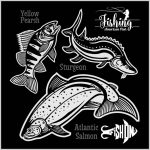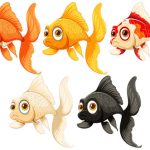1. Introduction to Catfish Species in the U.S.
Catfish are one of the most popular game fish in the United States, known for their hard fight and delicious flavor. Whether youre fishing rivers in the South or lakes in the Midwest, understanding the different species of catfish can make a big difference in your success. In this section, we’ll take a look at the three most common types of catfish found across the country: channel catfish, blue catfish, and flathead catfish.
Channel Catfish
The channel catfish is the most widespread and commonly caught catfish species in the U.S. Theyre especially popular among recreational anglers due to their abundance and willingness to bite on a variety of baits. Channel cats prefer slow-moving rivers, reservoirs, ponds, and small lakes with muddy or sandy bottoms. They are often found near submerged logs, brush piles, or along creek channels.
Key Features of Channel Catfish:
- Color: Light blue to olive with scattered black spots (young ones)
- Size: Typically 1–10 lbs; record catches can exceed 40 lbs
- Habitat: Warm freshwater systems nationwide
Blue Catfish
Blue catfish are known for their size and strength, making them a favorite target for trophy hunters. They are native to large rivers like the Mississippi, Missouri, and Ohio but have been introduced into many other water bodies across the South and Mid-Atlantic regions. Blues prefer deep, fast-moving waters with strong current and structure like river bends or drop-offs.
Key Features of Blue Catfish:
- Color: Solid blue-gray with no spots
- Size: Commonly over 20 lbs; can grow past 100 lbs
- Habitat: Large river systems and reservoirs
Flathead Catfish
Flathead catfish are unique both in appearance and behavior. Unlike channel and blue cats that scavenge, flatheads prefer live prey like sunfish or shad. They thrive in slower-moving rivers and large creeks with submerged cover such as fallen trees or rock ledges. Flatheads are mostly found in the central and southeastern U.S., but their range has expanded over time.
Key Features of Flathead Catfish:
- Color: Mottled brown/yellow with a flat head
- Size: Often 10–50 lbs; some reach over 100 lbs
- Habitat: Slow-moving rivers with heavy cover
Comparison Table of Common U.S. Catfish Species
| Species | Common Size Range | Max Size | Main Habitat | Preferred Bait |
|---|---|---|---|---|
| Channel Catfish | 1–10 lbs | Over 40 lbs | Lakes, ponds, slow rivers | Dough bait, worms, cut bait |
| Blue Catfish | 10–50+ lbs | Over 100 lbs | Large rivers & reservoirs | Cut bait, live shad |
| Flathead Catfish | 10–50 lbs | Over 100 lbs | Slow rivers w/structure | Live bait (sunfish, perch) |
This basic understanding of each species will help you choose where to fish and what gear or bait to use depending on your location. Knowing which catfish you’re after is key before you hit the water.
2. Essential Gear for Catfishing
When it comes to catfish fishing across the United States, having the right gear can make all the difference. Whether youre targeting channel cats in a local river or going after monster blue cats in a reservoir, using the proper setup will help you land more fish and enjoy the experience.
Rods
Catfish are strong fighters, so your rod needs to be tough and durable. Look for medium-heavy to heavy power rods with a moderate to fast action. The length of the rod typically ranges from 7 to 9 feet, giving you the leverage needed for long casts and battling big fish.
Recommended Rod Types
| Rod Type | Best For | Length | Power/Action |
|---|---|---|---|
| Spinning Rod | Beginner-friendly, smaller catfish | 66″ – 8 | Medium to Medium-Heavy / Moderate |
| Casting Rod | Larger catfish, precision casting | 7 – 9 | Medium-Heavy to Heavy / Fast |
| SURF Rod | Bank fishing, long-distance casting | 9 – 12 | Heavy / Moderate-Fast |
Reels
A quality reel matched to your rod is essential. Both spinning and baitcasting reels work well, but baitcasters are often preferred for targeting trophy-size catfish due to their strength and line control.
Recommended Reel Types
| Reel Type | Best For | Main Feature |
|---|---|---|
| Spinning Reel | Beginners, light tackle setups | User-friendly, quick setup |
| Baitcasting Reel | Larger fish, heavy lines | Better drag control and power |
| Spincast Reel | Youths or casual anglers | Simplified design, less backlash risk |
Fishing Line Choices
Your line needs to withstand abrasions and fight powerful fish. Most anglers use monofilament or braided line depending on the fishing environment and target species.
Line Comparison Chart
| Line Type | Strengths | Best Used For | Pound Test Range (Typical) |
|---|---|---|---|
| Monofilament (Mono) | Stretchy, forgiving, affordable | Banks, rivers with light cover | 15 – 30 lb test for average catfish; up to 50 lb for big blues or flatheads |
| Braided Line (Braid) | No stretch, high sensitivity, very strong diameter-to-strength ratio | Heavy cover areas, deep water fishing | 30 – 80 lb test depending on target size |
| Fluorocarbon Leader | Abrasion-resistant, invisible underwater | Tying leaders when targeting skittish fish | 20 – 50 lb test |
Terminal Tackle Essentials
Your terminal tackle—the hooks, weights, swivels, and rigs—is what connects you directly to the fish. Here are some commonly used items in catfishing:
- Circular Hooks: Ideal for catch-and-release; they hook fish in the corner of the mouth.
- Kahle Hooks: Great for cut bait; offer deeper penetration.
- Sinker Weights: Egg sinkers or no-roll sinkers help keep your bait on bottom where catfish feed.
- Snap Swivels: Reduce line twist and make rig changes easy.
Bait Selection: What Catfish Love Most
The right bait can turn a slow day into an unforgettable one. Catfish are opportunistic feeders with a keen sense of smell. Here’s a breakdown of effective bait choices:
Bait Options Overview
| Bait Type | Description | Best For |
|---|---|---|
| Live Bait (Shad, Bluegill, Nightcrawlers) | Mimics natural prey; triggers aggressive strikes | Larger blues and flatheads |
| Cut Bait (Shad chunks, Carp pieces) | Scent disperses through water; easy to prepare | Lakes and rivers with current; all species |
| Stink Baits (Dip baits, Punch baits) | Pungent smell attracts channel catfish fast | Pond or small lake fishing; channels especially |
Selecting your gear based on your target species and fishing location is key. Whether youre wading into muddy riverbanks or setting up from a boat offshore, getting these essentials right will set you up for a successful catfishing adventure.

3. Effective Catfishing Techniques
When it comes to catching catfish in the U.S., there’s no one-size-fits-all method. The best technique often depends on the season, water conditions, and the type of catfish youre targeting. Below are some tried-and-true methods that anglers across the country use, along with tips on when and where to use them.
Bottom Fishing
Bottom fishing is one of the most popular and straightforward ways to catch catfish. Since catfish are bottom dwellers, this method puts your bait right where they feed. Use a heavy sinker to keep your bait anchored near the bottom of rivers, lakes, or reservoirs. It works great year-round but especially during summer when catfish are actively feeding.
Tips:
- Use stink baits or cut bait to attract channel cats.
- A slip sinker rig helps your bait stay on the bottom while allowing the fish to take it without feeling resistance.
- Fish near underwater structures like logs, rocks, or drop-offs.
Drift Fishing
Drift fishing involves letting your boat move naturally with the wind or current while dragging baited lines behind you. This technique covers a lot of water and helps locate actively feeding fish, especially blue catfish in large reservoirs or river systems.
Tips:
- Use multiple rods to increase your chances of finding fish.
- Keep your bait just off the bottom using a drift rig or Santee Cooper rig.
- Best used in spring and fall when water temperatures are moderate.
Jugging
Jug fishing (or jugging) uses floating jugs or bottles rigged with lines and baited hooks. It’s a fun and effective way to catch catfish in lakes and slow-moving rivers. Set them out and watch them drift—when a jug starts moving fast or bobbing erratically, you’ve got a fish!
Tips:
- Label your jugs with your name and contact info as required by local laws.
- Use strong line (at least 30 lb test) and circle hooks for better hooksets.
- Check jugs frequently to avoid harming fish or losing them altogether.
Trotlining
Trotlines are long mainlines anchored at both ends with several baited hooks hanging down from short leaders. This passive fishing method is ideal for catching multiple catfish overnight or over several hours in rivers or lakes.
Tips:
- Space hooks evenly about 2–3 feet apart.
- Bait with a mix of live bait (like shad) and cut bait to attract different species.
- Make sure trotlines are legal in your area and follow all regulations.
Choosing the Right Technique by Season & Conditions
The effectiveness of each technique can vary depending on time of year and water clarity, temperature, or flow rate. Heres a quick reference guide:
| Season | Recommended Techniques | Why It Works |
|---|---|---|
| Spring | Drift Fishing, Bottom Fishing | Catfish are active after winter; cover more water to find them. |
| Summer | Trotlining, Jugging, Night Bottom Fishing | Warm water boosts activity; night fishing avoids heat and crowds. |
| Fall | Drift Fishing, Bottom Fishing | Cats feed heavily before winter; follow bait movement patterns. |
| Winter | Simplified Bottom Fishing (deep holes) | Fish slow down; focus on deeper holes where they gather. |
No matter which method you choose, adapting your strategy based on local conditions will greatly improve your success on the water. Try different techniques until you find what works best for your target species and location.
4. Top Catfish Fishing Locations Across the U.S.
When it comes to catfishing, the United States is home to some of the best spots in the world. From wide rivers and deep lakes to calm reservoirs, each region offers unique opportunities for anglers targeting channel, blue, or flathead catfish. In this section, we’ll highlight top catfish fishing locations in states known for their rich catfishing traditions—Texas, Missouri, Mississippi, and Tennessee—along with local regulations and tips based on seasonal patterns.
Texas
Texas is a powerhouse for catfish fishing, thanks to its vast freshwater systems. The Lone Star State boasts a variety of prime locations:
| Location | Catfish Species | Best Season | Notes |
|---|---|---|---|
| Lake Tawakoni | Blue, Channel | Winter (for trophy blues) | Known as the “Catfish Capital of Texas” |
| Brazos River | Flathead, Channel | Spring & Summer | Great for kayak fishing and bank access |
| Trinity River | Blue, Flathead | Fall & Winter | Trophy-sized blues are common here |
Missouri
With the mighty Mississippi and Missouri Rivers running through it, Missouri is a favorite among serious catfish anglers.
| Location | Catfish Species | Best Season | Notes |
|---|---|---|---|
| Missouri River | Blue, Flathead | Late Spring to Early Fall | A hotspot for big river catfishing techniques |
| Lake of the Ozarks | Channel, Blue, Flathead | Summer Months | Easily accessible with plenty of boat ramps |
| Truman Reservoir | Channel, Blue | Spring & Summer | Covers 55,600 acres with diverse habitats |
Mississippi
The state of Mississippi is home to several fertile bodies of water perfect for catching trophy catfish.
| Location | Catfish Species | Best Season | Notes |
|---|---|---|---|
| Mighty Mississippi River (state border) | Blue, Flathead, Channel | Semi-Year-Round (peak in summer) | Trophy blues are frequently caught here using cut bait and heavy rigs. |
| Sardis Lake | Channel Catfish | Late Spring through Summer | A favorite spot for shore anglers and families alike. |
| Eagle Lake (near Vicksburg) | Channel, Blue Catfish | Semi-Year-Round (best in spring) | This oxbow lake offers both shallow and deep fishing zones. |
Tennessee
Tennessees rivers and lakes offer excellent conditions for all three major species of catfish. The state has also become a destination for trophy blue cat hunters.
| Location | Catfish Species | Best Season | Notes |
|---|---|---|---|
| Tennessee River (Chickamauga Dam area) | Trophy Blue Catfish | Late Fall through Winter for big blues; Year-round action available. | |
| Kentucky Lake (extends into TN) | Channel, Blue, Flathead Catfish | Largely Spring & Summer months | Great structure and current breaks perfect for anchoring or drifting. |
| Mississippi River (Western TN border) | Blue , Flathead | Summer | Fast-moving currents make this ideal for experienced river anglers. |
Local Regulations & Licensing Tips
Each state has its own set of rules when it comes to size limits , daily bag limits , and legal methods . Here are a few key reminders :
- Always check your states fish and game website before planning a trip.
- In many states like Texas and Tennessee , trotlines , jug lines , and limb lines are allowed but regulated .
- Some areas may require special permits for night fishing or using live bait .
- Catch – and – release is encouraged in trophy waters to sustain healthy populations .
Seasonal Patterns Matter
Understanding when to fish can be just as important as where . Heres a general guide :
| Season | What to Expect | Tips |
|---|---|---|
| Spring | Catfish begin spawning prep ; more active near banks . | Use stink baits or live bait near shallow cover . |
| Summer | Peak activity ; feeding aggressively . | Drift fishing or night fishing works great . |
| Fall | Transition period ; fish move to deeper holes . | Focus on deep channels using cut bait . |
| Winter | Trophy blue cats bite well in cold weather . | Anchor near deep water ledges with fresh cut shad . |
Whether youre casting from a riverbank in Tennessee or drifting across a Texas reservoir, knowing the best spots—and when to go—can help you land that monster cat youve been dreaming about.
5. Tips for Success and Safety on the Water
Catfish fishing can be an exciting adventure, but success on the water also means being prepared, knowing what to expect, and staying safe—especially when youre out on rivers or in remote areas. Here are some helpful tips covering bite patterns, how to handle big cats, must-have night gear, and safety practices that every angler should follow.
Recognizing Catfish Bite Patterns
Understanding how catfish bite can greatly improve your hook-up rate. Unlike many other fish species, catfish bites can vary depending on their size and species.
| Catfish Type | Bite Pattern | What to Do |
|---|---|---|
| Channel Catfish | Quick taps or pecks | Wait for a steady pull before setting the hook |
| Blue Catfish | Strong, steady pull | Set the hook firmly as soon as the rod loads up |
| Flathead Catfish | Slow, heavy bite with line movement | Give them a few seconds, then set the hook hard |
Handling Big Catfish Safely
Larger catfish can be powerful and tough to manage once you get them to the boat or shore. Heres how to handle big fish safely:
- Use a landing net: Especially helpful for fish over 10 lbs.
- Grip behind the pectoral fins: This gives you better control without harming the fish.
- Avoid putting fingers in their mouth: Big cats have strong jaws and rough pads that can scrape your skin.
- If releasing, keep handling quick and gentle: Support the belly and hold them horizontally.
Essential Night Fishing Gear
Catching catfish at night is a favorite method among seasoned anglers. Make sure you’re equipped with the right tools to stay effective and safe after dark:
| Gear Item | Description |
|---|---|
| Headlamp or LED flashlight | Keeps your hands free while providing visibility around your gear and setup area. |
| Chemical light sticks or rod tip lights | Easily spot bites in low light by attaching these to your rod tips. |
| Luminous bobbers or bells | Adds audio or visual alerts when a catfish strikes. |
| Reflective tape or markers | Makes it easier to find gear and avoid tripping hazards. |
River and Remote Area Safety Practices
Certain catfishing spots may be far from help or involve stronger currents. Always take steps to protect yourself during these trips:
Packing Essentials:
- First aid kit: Cuts from hooks or fins are common.
- PFD (Personal Flotation Device): A must if youre fishing from a boat or wading in deep water.
- Plenty of drinking water: Stay hydrated, especially in hot weather.
- A fully charged phone or radio: For emergencies where cell service is available.
Avoiding Common Hazards:
- Watch for fast currents: Riverbanks can be slippery; wear sturdy shoes with grip.
- Avoid fishing alone in remote areas at night: Bring a buddy whenever possible.
- Stay aware of wildlife: Snakes, insects, or even larger animals may be nearby—keep your campsite clean and sealed.
A little preparation goes a long way. With these tips in mind, youll be ready to enjoy a productive—and safe—catfishing trip anywhere across the United States.


